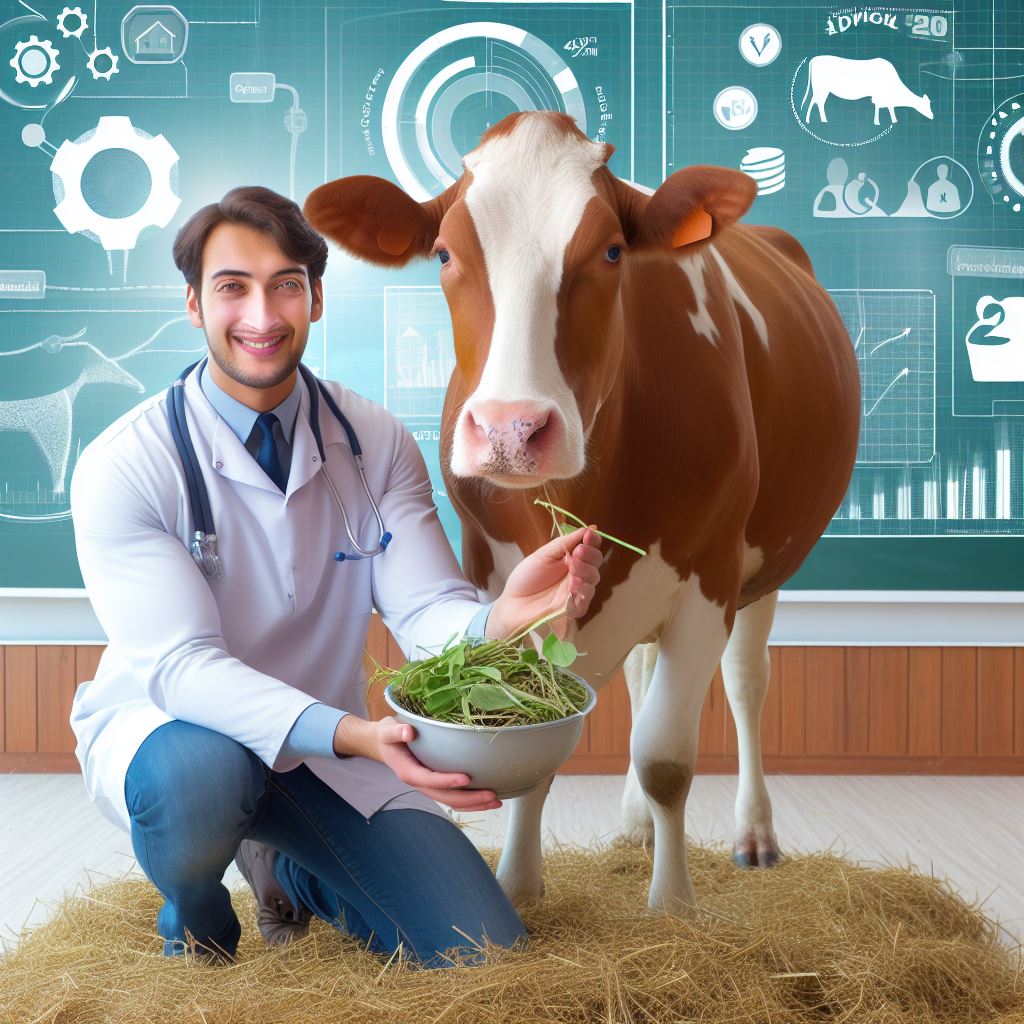Introduction to Green Goat Farming Methods
A. Brief explanation of the concept
In recent years, there has been a growing interest in green goat farming methods.
These methods aim to minimize the negative impact on the environment and promote sustainable practices.
Green goat farming involves utilizing natural resources efficiently, reducing waste, and ensuring the well-being of the animals.
B. Importance of sustainable farming practices
This approach is important because traditional farming practices can have detrimental effects on the environment, such as soil erosion and water pollution.
By adopting green farming techniques, farmers can contribute to the preservation of natural resources and the overall health of the ecosystem.
C. Transition to green farming techniques
Transitioning to green farming requires careful planning and implementation of new practices, such as organic feed, rotational grazing, and natural pest control.
The use of chemical fertilizers and pesticides is minimized, and instead, natural methods such as composting and crop rotation are utilized.
Green goat farming methods also emphasize the health and well-being of the animals.
Farmers provide spacious and well-ventilated shelters for the goats, allowing them to roam freely and lead a more natural lifestyle.
Therefore, green goat farming methods are a sustainable and environmentally-friendly approach that promotes efficient resource utilization and animal welfare.
By adopting these practices, farmers can contribute to a healthier ecosystem and a more sustainable future.
Benefits of Green Goat Farming Methods
Goat farming plays a crucial role in sustainable agriculture, offering numerous benefits to both the environment and farmers.
By adopting green goat farming methods, farmers can contribute to reducing their carbon footprint, preserving natural resources, improving soil health and fertility, enhancing biodiversity, and enjoying economic advantages.
Let’s delve deeper into each of these advantages:
A. Reduced carbon footprint
- Green goat farming methods prioritize sustainable practices that minimize greenhouse gas emissions.
- By implementing rotational grazing, where goats are moved to different pasture areas, overgrazing is prevented.
- This rotational system allows plants time to regenerate, ensuring healthier vegetation and reducing carbon emissions.
B. Preservation of natural resources
- Green goat farming practices involve utilizing natural resources efficiently, minimizing waste.
- By utilizing goat manure as organic fertilizer, the need for harmful chemical fertilizers is decreased.
- Conserving water resources is vital in green goat farming, achieved through advanced watering techniques, such as drip irrigation.
C. Improved soil health and fertility
- Green goat farming methods focus on soil health by preventing erosion and maintaining soil structure.
- Goats, through their grazing behavior, help in controlling weeds, reducing the need for herbicides.
- By consuming plants and releasing their nutrient-rich manure, goats contribute to soil fertility and microbial activity.
D. Enhancement of biodiversity
- Green goat farming promotes the preservation and restoration of diverse ecosystems.
- Rotational grazing encourages the growth of native grasses, flowering plants, and shrubs, providing habitat for diverse animal species.
- Goats’ selective browsing helps in controlling invasive plant species, maintaining ecological balance.
E. Economic advantages for farmers
- Green goat farming methods offer economic benefits through cost savings and increased market demand.
- By minimizing the use of chemical inputs, farmers reduce expenses on synthetic fertilizers and herbicides.
- The growing demand for organic and sustainably produced goat products opens up new market opportunities, securing higher profits.
Overall, green goat farming methods bring a wide range of benefits to both the environment and farmers.
Transform Your Agribusiness
Unlock your farm's potential with expert advice tailored to your needs. Get actionable steps that drive real results.
Get StartedBy reducing the carbon footprint, preserving natural resources, improving soil health, enhancing biodiversity, and providing economic advantages, farmers contribute to a sustainable and profitable farming system.
Embracing these sustainable practices not only benefits individual farms but also plays a crucial role in building a greener and healthier agricultural sector.
Read: Organic Poultry: Best Practices
Sustainable Grazing Systems
A. Rotational grazing
Rotational grazing, also known as controlled grazing, is an effective sustainable grazing system.
In this system, animals are moved to fresh pasture frequently, allowing the previously grazed area to recover its forage supply.
By rotating animals among different paddocks, grazing pressure can be evenly distributed, preventing overgrazing and promoting healthy grass growth.
B. Managed intensive
Managed intensive grazing, on the other hand, involves keeping high animal density in a specific area for a short period.
The animals rapidly graze the available forage and are then moved to a new area.
This method promotes optimal forage utilization by concentrating the animals’ grazing impact in a small space.
It encourages the animals to eat more selectively, thereby minimizing waste and maximizing feed intake.
C. Utilizing paddocks or pasture divisions
To implement these grazing systems, farmers need to divide their pastures into smaller paddocks or sections.
This division helps control the timing and duration of grazing in each area.
The number of paddocks depends on the available land and the number of animals to be grazed.
Fences or temporary electric fencing can be used to create and shift paddocks as needed.
D. Providing ample forage and avoiding overgrazing
Providing ample forage is vital in sustainable goat farming.
High-quality pasture or forage should be available in all paddocks to meet the animals’ nutritional needs.
Planning grazing rotations can help ensure a steady supply of fresh forage in each paddock.
Monitoring the grazing intensity is also essential to prevent overgrazing, which can lead to reduced forage quality and quantity.
Overgrazing should be avoided at all costs. It causes soil erosion, reduces water infiltration, and increases nutrient runoff.
Additionally, overgrazed pastures are more susceptible to weed invasion, as the weakened grass struggles to compete against opportunistic plants.
To prevent overgrazing, farmers must closely monitor the condition of the pastures and adjust the grazing pressure accordingly.
Sustainable grazing systems offer many benefits. They improve soil health by promoting organic matter decomposition and nutrient cycling.
Properly managed grazing can also enhance biodiversity by creating a mosaic of different vegetation heights and types.
Additionally, these systems can reduce the reliance on mechanical or chemical weed control methods, resulting in cost savings and minimized environmental impact.
Showcase Your Farming Business
Publish your professional farming services profile on our blog for a one-time fee of $200 and reach a dedicated audience of farmers and agribusiness owners.
Publish Your ProfileMost importantly, sustainable grazing systems such as rotational grazing and managed intensive grazing are valuable methods for green goat farming.
By utilizing paddocks, providing ample forage, and avoiding overgrazing, farmers can create a harmonious balance between animal welfare, forage productivity, and environmental conservation.
Implementing these practices is key to building a resilient and sustainable goat farming enterprise.
Read: Ethical Pig Farming Essentials
Organic Feed and Forage Management
Organic feed and forage management is an essential aspect of green goat farming.
By focusing on utilizing organic feed sources and incorporating forage crops in their diet, farmers can enhance the health and productivity of their goats.
This approach brings numerous benefits, such as a diverse diet and reduced dependence on external feed sources.
A. Utilizing organic feed sources
Utilizing organic feed sources is a key component of green goat farming.
Farmers must carefully select feeds that are certified organic and free from chemical additives.
This ensures that goats consume a nutritious and healthy diet, minimizing the risk of diseases and promoting their overall well-being.
B. Incorporating forage crops in the diet
Incorporating forage crops in the diet of goats is another crucial aspect of green farming practices.
Forage crops, such as alfalfa, clover, and lespedeza, are rich in essential nutrients and minerals.
By allowing goats to graze on these crops, farmers can provide them with a natural and balanced diet.
C. Benefits of diverse diet for goats
This diverse diet has numerous benefits for goats.
It helps in improving their digestive health, enhances their immune system, and promotes healthy weight gain.
Additionally, forage crops contain phytochemicals that have antioxidant and anti-inflammatory properties, further improving the goats’ overall health and resistance to diseases.
D. Reducing dependence on external feed sources
Another advantage of incorporating forage crops is the reduction in the dependence on external feed sources.
Growing forage crops on the farm provides a sustainable and cost-effective solution.
Farmers can save on purchasing commercial feeds, which are often sourced from distant locations and may have a higher carbon footprint due to transportation.
By using forage crops, farmers also contribute to the sustainability of their farm’s ecosystem.
Crop rotation practices can be employed, which help maintain soil fertility, reduce erosion, and control weeds naturally.
This supports a healthier and more resilient environment for the goats and other livestock.
In addition to forage crops, farmers can explore other alternatives such as silage and hay production.
These methods involve fermenting and preserving high-quality forage, ensuring a continuous supply of nutritious feed throughout the year.
This not only reduces waste but also ensures that goats have access to good quality feed during periods of scarcity.
Integrating organic feed and forage management practices into green goat farming systems is a sustainable approach that supports both the health of the animals and the environment.
It reduces the reliance on external feed sources and promotes the use of natural, organic resources available on the farm.
In essence, organic feed and forage management play a vital role in green goat farming.
Utilizing organic feed sources and incorporating forage crops in the diet of goats bring numerous benefits, including a diverse diet, improved health, and reduced dependence on external feed sources.
These practices contribute to the sustainability and long-term success of green goat farming methods.
Read: Sustainable Sheep Rearing Tips

Natural Weed Control Methods
A. Implementing Biological Controls
Biological control methods involve using natural enemies to regulate weed populations.
Introducing insects, such as weevils or beetles, that feed on specific weeds can help control their growth.
This method reduces the need for chemical herbicides, making it an eco-friendly approach to weed management.
B. Utilizing Goats as Natural Weed Eaters
Goats are excellent natural weed eaters and can be utilized to control weed growth.
Their grazing habits and preference for broadleaf plants make them perfect for managing weed populations.
By allowing goats to graze in targeted areas, farmers can keep weeds at bay without relying on chemicals.
C. Benefits of Weed Control Without Chemicals
Using natural methods for weed control offers several advantages over chemical-based solutions.
There is no risk of chemical residue on crops, ensuring safer and healthier produce.
Natural weed control methods also promote biodiversity by preserving beneficial insects and plants.
Showcase Your Farming Business
Publish your professional farming services profile on our blog for a one-time fee of $200 and reach a dedicated audience of farmers and agribusiness owners.
Publish Your ProfileFurthermore, these methods are usually cost-effective and sustainable in the long run.
D. Preventing Environmental Contamination
Chemical weed control methods contribute to environmental contamination.
Pesticides and herbicides may leach into groundwater, contaminating drinking water sources.
These chemicals can also harm non-target organisms, including birds, fishes, and beneficial insects.
By opting for natural weed control methods, farmers can reduce the risk of environmental pollution.
Implementing natural weed control methods is essential for sustainable and eco-friendly goat farming.
By using biological controls and utilizing goats as weed eaters, farmers can manage weed growth effectively.
These methods offer multiple benefits, including safer produce, biodiversity preservation, and cost-effectiveness.
Moreover, they help prevent environmental contamination, promoting a healthier and greener farming environment.
In fact, natural weed control methods have numerous advantages over chemical alternatives.
By embracing these eco-friendly approaches, goat farmers can achieve efficient weed management.
Implementing biological controls and utilizing goats as weed eaters can effectively reduce weed populations.
Additionally, these methods promote healthier farming practices, prevent environmental contamination, and preserve biodiversity.
In today’s world, where sustainability and ecological balance are crucial, adopting natural weed control methods is a step towards a greener future.
Read: Eco-Friendly Beef Farming: A Guide
Waste Management Strategies
Waste management is a crucial aspect of green goat farming methods.
By implementing effective strategies, farmers can ensure sustainable practices that benefit both their goats and the environment.
A. Composting Goat Manure
- Composting is a fantastic way to manage goat manure responsibly.
- This process involves collecting manure and allowing it to decompose naturally.
- During composting, microorganisms break down the organic matter, transforming it into nutrient-rich compost.
- The compost can then be used as a natural fertilizer for crops or pasture grass.
- Not only does composting reduce waste, but it also helps improve soil health.
- The nutrients and beneficial microorganisms in the compost enrich the soil and promote plant growth.
B. Utilizing Manure as Fertilizer
- Instead of relying on synthetic fertilizers, green goat farmers can utilize goat manure as an organic alternative.
- Goat manure is rich in nitrogen, phosphorus, and potassium, essential nutrients for plant growth.
- By properly composting the manure, farmers can ensure its effectiveness as a fertilizer.
- Applying the compost to fields or gardens nourishes the soil and avoids the use of synthetic chemicals.
- This practice reduces pollution and promotes a healthier ecosystem.
C. Importance of Proper Waste Management for Sustainability
- Proper waste management is vital to ensure the long-term sustainability of goat farming.
- Without effective strategies in place, waste can accumulate, leading to environmental issues.
- By implementing proper waste management techniques, farmers can maintain a clean and healthy environment for their goats.
- This also enhances the overall efficiency of the farm and reduces the risk of disease transmission.
- Furthermore, sustainable waste management practices contribute to the conservation of natural resources.
D. Reducing Pollution and Dependency on Synthetic Fertilizers
- Green goat farming methods aim to minimize pollution and reduce dependency on synthetic fertilizers.
- By composting goat manure and utilizing it as fertilizer, farmers eliminate the need for chemicals.
- Synthetic fertilizers often contain harmful substances that can degrade soil quality and pollute waterways.
- By adopting sustainable waste management strategies, farmers actively contribute to a cleaner environment.
- Moreover, reducing synthetic fertilizer use helps preserve biodiversity and protect natural habitats.
In short, waste management strategies play a significant role in promoting sustainability in green goat farming.
Composting goat manure and utilizing it as fertilizer not only reduces waste but also benefits the soil and crops.
Implementing proper waste management practices is crucial for maintaining a healthy environment, minimizing pollution, and reducing dependency on synthetic fertilizers.
Green goat farmers understand the importance of responsible waste management for the long-term success of their farms and the preservation of natural resources.
Discover More: Maximizing Profit in Small Scale Poultry
Integrating Sustainable Infrastructure
A. Use of renewable energy sources
Utilizing renewable energy sources, such as solar and wind power, is an integral part of sustainable goat farming practices.
By harnessing the power of nature, farmers can reduce their carbon footprint and contribute positively to the environment.
Solar panels and wind turbines are excellent options for generating clean energy on goat farms.
B. Installing solar panels or wind turbines
Solar panels, which convert sunlight into electricity, can be installed on various structures to generate power for various farming activities.
These panels absorb sunlight, which is then converted into electricity through photovoltaic cells.
The electricity can be used to power lighting, heating, ventilation systems, and even electric fences.
This helps reduce dependence on traditional energy sources and lowers electricity bills.
Similarly, wind turbines can convert kinetic energy from the wind into electricity.
These structures feature large blades that rotate when wind blows.
This rotation generates electricity through a generator.
Wind turbines are especially suitable for farms located in windy regions.
By harnessing the power of the wind, farmers can generate free and clean energy. Installing wind turbines requires careful consideration of wind direction and strength.
C. Rainwater harvesting techniques
Implementing rainwater harvesting techniques is another important aspect of sustainable infrastructure on a goat farm.
Harvesting rainwater allows farmers to collect and store rainwater for various uses.
Rainwater can be used for irrigation, cleaning purposes, and even for providing animals with drinking water.
By relying on rainwater, farmers reduce the burden on external water sources and conserve precious freshwater resources.
D. Sustainable infrastructure for goat housing and milking facilities
Sustainable infrastructure for goat housing is crucial for ensuring the well-being of the animals and minimizing their impact on the environment.
Goat houses should be constructed using eco-friendly materials that are durable, well-insulated, and provide adequate ventilation.
Showcase Your Farming Business
Publish your professional farming services profile on our blog for a one-time fee of $200 and reach a dedicated audience of farmers and agribusiness owners.
Publish Your ProfileThis helps create a comfortable and healthy living environment for the goats while minimizing energy consumption.
Additionally, sustainable infrastructure should be implemented in milking facilities.
Proper waste management systems, such as composting or biogas production, should be in place to handle manure effectively.
This ensures that the waste is not just disposed of but rather used as a resource. Composted manure can be utilized as organic fertilizer, while biogas can be used as a renewable energy source.
In review, integrating sustainable infrastructure on goat farms is essential for promoting eco-friendly practices and ensuring their long-term viability.
Utilizing renewable energy sources like solar panels and wind turbines reduces carbon footprint and lowers energy costs.
Rainwater harvesting techniques help conserve water resources, while sustainable infrastructure for goat housing and milking facilities minimizes environmental impact.
By prioritizing sustainable infrastructure, goat farmers can contribute positively to the environment while maintaining the health and well-being of their animals.
Conclusion
After exploring the benefits of green goat farming methods, it is clear that they offer numerous advantages.
By adopting sustainable practices, farmers can enhance their environmental impact while increasing their productivity.
Green goat farming methods contribute to soil conservation, water preservation, and reduced greenhouse gas emissions.
These practices also promote biodiversity and protect natural habitats.
Furthermore, by utilizing organic fertilizers, rotating pastures, and practicing integrated pest management, farmers can ensure the health and welfare of their goats while producing high-quality and nutritious meat, milk, and fiber.
Additionally, green goat farming methods offer financial benefits such as reduced input costs, increased market demand for eco-friendly products, and potential government incentives.
Encouragement for farmers to adopt these sustainable practices is crucial.
Education, training programs, and cooperative initiatives can help them transition and overcome potential challenges.
Looking towards the future, there are exciting prospects and potential advancements in the field of green goat farming.
Research on innovative feeding methods, renewable energy integration, and genetic improvement can further enhance sustainability and efficiency.
The implementation of green goat farming methods is a win-win situation for both farmers and the environment.
By embracing sustainable practices, farmers can secure a better future for themselves, their animals, and the planet.




